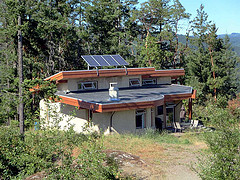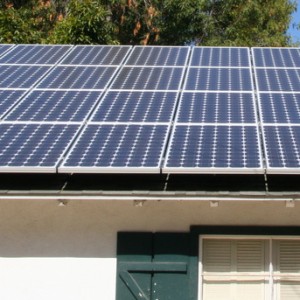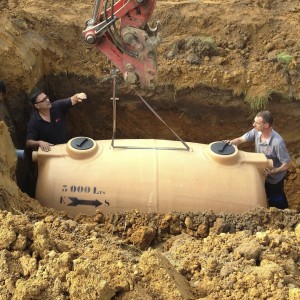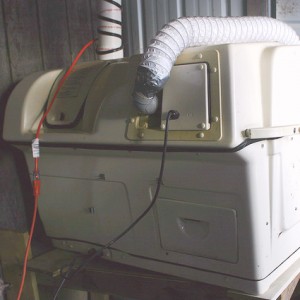(Stephen met his wife Rachel at a house party hosted by his brother)
 Last time we talked about getting out of debt and saving for the future. Now that you have a budget in place, you can start saving. You may be asking yourself, “What am I saving for?” and “How much do I need?”
Last time we talked about getting out of debt and saving for the future. Now that you have a budget in place, you can start saving. You may be asking yourself, “What am I saving for?” and “How much do I need?”
Besides paying off all of your debt, you’ll need some start up capital to start your new lifestyle. I have worked up these estimates to give you an idea of how much money you’ll need to start living off the grid. Not all of the below estimates will apply to your preferred off grid lifestyle, so just refer to those that do.
| Low | Average | |
| Property | $0.00 | $25,000.00 |
| Shelter | $0.00 | $150,000.00 |
| Solar/Wind Power | $1,000.00 | $37,000.00 |
| Wells & Water | $5,000.00 | $20,000.00 |
| Septic System | $2,500.00 | $5,000.00 |
| Composting Toilets | $100.00 | $5,000.00 |
| Grey Water | $500.00 | $1,000.00 |
| Geothermal | $7,500.00 | $20,000.00 |
| Garden | $100.00 | $2,500.00 |
| Livestock | $1,000.00 | $5,000.00 |
| Aquaponics | $1,000.00 | $10,000.00 |
| Outbuildings | $2,000.00 | $30,000.00 |
| Total | $20,700.00 | $310,500.00 |
Property – Low $0, Average $25,000

You can find land for free, but those lots may not be ideal. There is a reason why they are free. Sometimes there are not free conditions that come with the free land.
If you decide that free is not for you, then for $20,000 to $30,000 you can get a 1 to 5 acre lot almost anywhere. I have heard of people finding better deals. With realty you just have to look and be patient to find the good deals.
The states with the best gardening potential are North Carolina, Kentucky, Texas, California, Florida, Missouri, New Jersey, Arkansas, and the Hawaiian Islands. Here are some realty sites to help you start your search: http://www.realtor.com/, http://www.landandfarm.com/, http://www.loopnet.com/
Shelter – Low $0, Average $150,000
 If you do your land shopping correctly, you can find a piece of land with a home on it already. If you bought an undeveloped piece of land, you will have to worry about roads, excavation, and home building. If you are crafty, you can use timber from your land to build your own cabin or sometimes a forestry company will pay you to allow them to clear the land for you.
If you do your land shopping correctly, you can find a piece of land with a home on it already. If you bought an undeveloped piece of land, you will have to worry about roads, excavation, and home building. If you are crafty, you can use timber from your land to build your own cabin or sometimes a forestry company will pay you to allow them to clear the land for you.
Otherwise you will need to hire a contractor. Most anywhere in the United States you can build a stick frame home for $120,000 to $150,000. If you want, you can build a rammed earth home for around $200,000. If you would like to go cheap, you can buy a single wide manufactured home for about $20,000. Depending on your situation, you may be able to start with a nice tent for about $500.
Remember, one of your goals should be to stay out of debt. You should consider starting off small and working your way up.
Solar/Wind Power System – Low $1,000, Average $37,000
 To build an alternative power system you need at least one solar panel or wind turbine and one inverter. This will cost you about $1,000. However, this will only produce about enough electricity to run one chest freezer or a high efficient solar fridge.
To build an alternative power system you need at least one solar panel or wind turbine and one inverter. This will cost you about $1,000. However, this will only produce about enough electricity to run one chest freezer or a high efficient solar fridge.
You can upgrade this system by adding as many solar panels and wind turbines as you need. The average cost of a system that produces enough electricity for an average home is somewhere around $30,000.
If you want to be independent of the electrical grid you will need batteries as well. Batteries themselves are $200 to $300 a piece new and a proper back up system would be about $7,000 on average. Keep in mind that you will need to upkeep and replace batteries every few years. I have heard that you can pick up used batteries from server farm companies for pretty cheap.
Wells – Low $5,000, Average $20,000
 If you buy the right piece of land, you may have access to a natural source of fresh water, like a stream. Keep in mind that if you use stream or lake water, you may have to do some water treatment before use. If no fresh water is to be found, then you will need a well.
If you buy the right piece of land, you may have access to a natural source of fresh water, like a stream. Keep in mind that if you use stream or lake water, you may have to do some water treatment before use. If no fresh water is to be found, then you will need a well.
To install a well, you need to drill the hole and install a pump. Most well installation companies charge by the foot. If you don’t have to drill very deep, your well can be really reasonable. On the other hand, if you have to drill deep, it could get expensive.
The average depth of a well ranges between 100-150 feet deep. The price per foot ranges from $15-$100, for a total cost of the hole ranging from $3,000 to $50,000+. In additional to that, you will need $800-$2,000 for the pump, the adjoining plumbing and electrical work. Don’t forget a water storage tank, $500 to $1,000.
If you have big plans and want or need multiple wells, you may consider digging the wells yourself. You can buy a small hydraulic drilling rig for $10,000 to $15,000. There are units that attach to a Bobcat or a tractor, or you can stand alone units.
Septic System – Low $2,500, Average $5,000
 Septic systems are safe and can last for 20 to 40 years if maintained. For the most part they are not too expensive either, but there are some things that can make it pricey.
Septic systems are safe and can last for 20 to 40 years if maintained. For the most part they are not too expensive either, but there are some things that can make it pricey.
The biggest cost factor is the type of soil you are installing your system in. If your soil doesn’t drain or drains to well, your septic system will cost more. When you get a bid from a contractor, make sure you discuss your soil and the percolation test or perc test for short. Another factor is how many excavation companies are in your area and how hungry they are for work.
Here is a link to a site with a handy tool to help you determine the cost for your area. http://www.homeadvisor.com/cost/plumbing/install-a-septic-tank/
I still suggest that you contact your local contractor for a quote.
Composting Toilets – Low $100, Average $5,000
 Composting toilets break down human solid waste into a usable fertilizer by using the same process that is used to compost your kitchen scraps. With the combination of heat, aerobic bacteria, oxygen and time you can turn your poop into humus or humanure. The great thing about these systems is that they use very little to no water. The bad thing is that it does take some work and upkeep.
Composting toilets break down human solid waste into a usable fertilizer by using the same process that is used to compost your kitchen scraps. With the combination of heat, aerobic bacteria, oxygen and time you can turn your poop into humus or humanure. The great thing about these systems is that they use very little to no water. The bad thing is that it does take some work and upkeep.
You can get a new self contained unit for each for about $1,900 or you can build one for less than $100. Don’t forget you will need one of your bathrooms. The other option is a centralized system that connects multiple toilets to one central composter. These systems can cost $10,000 or more depending on your volume and needs.
Grey Water System – Low $500, Average $10,000
These systems capture the water from your shower, bathroom sinks, dish washer and clothes washer and re-use that water for your garden or for flushing toilets. Grey water systems vary greatly in price depending on how complex your system is, and whether or not you are installing it during the construction of your home or as a retrofit.
A simple system may allow the clothes washer to drain into a flower bed. This could be as cheap as $500.
A more complex system would gather water from all of the safe sources, filter it and then store it in a tank for use in the garden and for flushing toilets. This requires more plumbing, a storage tank and a pump. These systems could cost more than $10,000.
Geothermal Heat Pump – Low $7,500, Average $20,000
A geothermal heat pump uses a heat exchanger to take advantage of the constant temperature of the earth 8ft below the surface. Since it remains a fairly constant temperature of 50 deg F, you can use that to heat your home in the winter and cool it in the summer.
Like other systems, this one’s costs vary depending on the size of your home, the efficiency of your insulation, the space you have for an heat exchanging loop field, and if you are putting into a new home or retrofitting your old home. To know for sure, you’ll need to get a bid from a local contractor.
Gardening – Low $100, Average $2,500
 In order to produce enough vegetables for your family of 4 you are going to need about 4,000 sq ft of garden. If you buy seeds, it will take about $100 to get enough seeds each year. Once you get started, you may be able to save your seeds.
In order to produce enough vegetables for your family of 4 you are going to need about 4,000 sq ft of garden. If you buy seeds, it will take about $100 to get enough seeds each year. Once you get started, you may be able to save your seeds.
Most gardens need a fence to keep the critters out. This should cost you between $500 and $1,000 for woven wire, with chicken wire support. It will cost more if you install chain link. Don’t forget about irrigation. This could be as simple as a hose, or as complicated as a multi-timer system.
If you want berry bushes, grapes, fruit and nut trees, you’ll need to buy a variety. Each plant ranges from $15 to $100+ depending on your area and the size of the plant. You can quickly spend $1,000 or more before you know it.
Composting is free and it can actually save you money on fertilizer. All you need to do is start a pile somewhere in your yard. You do not need a fancy bin, although there are some that look nice and make life a little easier.
Livestock – Low $1,000, Average $4,000 , Monthly $320
 Chickens are relatively cheap. You can buy chickens at your local feed store for about $5 or $10 a piece and feed costs about $2 per chicken per month. A good rule of thumb is one laying hen per person in your household.
Chickens are relatively cheap. You can buy chickens at your local feed store for about $5 or $10 a piece and feed costs about $2 per chicken per month. A good rule of thumb is one laying hen per person in your household.
You will also need a coop. You can usually build one with scrap lumber for free, or you can buy one. Depending on your needs they start at $150 and go up from there.
 Pigs for food can cost from $15 to $100. Pigs for breeding can cost up to $3,000. One or two pigs should feed a family of four for a year. You will need a shelter and fencing for their pin, so you are looking at another $500+ for that. Feed can cost up to $50 a month per pig, but you can reduce that cost with garden or table scraps.
Pigs for food can cost from $15 to $100. Pigs for breeding can cost up to $3,000. One or two pigs should feed a family of four for a year. You will need a shelter and fencing for their pin, so you are looking at another $500+ for that. Feed can cost up to $50 a month per pig, but you can reduce that cost with garden or table scraps.
 Cows cost about $1,000 to $3,000 to buy, depending on the breed. One cow has enough meat to feed an average family of four for a year. Each cow will cost about $200 a month to feed. You can supplement this with scraps from your garden or a pasture. A good rule of thumb is at least one acre of pasture per cow. This of course will depend on your local vegetation. You will also spend about $2,500+ for fencing depending on how big your pasture is.
Cows cost about $1,000 to $3,000 to buy, depending on the breed. One cow has enough meat to feed an average family of four for a year. Each cow will cost about $200 a month to feed. You can supplement this with scraps from your garden or a pasture. A good rule of thumb is at least one acre of pasture per cow. This of course will depend on your local vegetation. You will also spend about $2,500+ for fencing depending on how big your pasture is.
If you get milk cows, you will save money on milk, butter, ice cream, cheeses and other dairy products. Also, if you have multiple cows you can raise calves for beef and/or for sale to help you pay for the feed.
Aquaponics – Low $1,000, Average $10,000
 For those of you who don’t know. Aquaponics is the joining of hydroponics (growing plants in water) and aquaculture (fish farming) into a self sustaining ecosystem. If done right you can produce vegetables and fish to feed your family year round. Year round systems require a green house.
For those of you who don’t know. Aquaponics is the joining of hydroponics (growing plants in water) and aquaculture (fish farming) into a self sustaining ecosystem. If done right you can produce vegetables and fish to feed your family year round. Year round systems require a green house.
A small aquaponics system can cost less than $500, but in order to feed a family of four you will probably spend close to $1,000 or more. Also if you want year around food, you will need a greenhouse big enough for your system, which will be about $5,000 to $10,000. In addition to that you will need upkeep your system with ph testers, fish food, water, electricity and other supplies.
Outbuildings – Low $2,000, Average $30,000
Greenhouses vary in price depending on the size. If you want one for starting your seeds early, you can get away with a smaller kit for about $750. If you want a larger one for year around growing you’ll probably need something closer to $10,000. You can also build one yourself for free if you are crafty enough. I built one out of salvaged sliding glass doors, some cinder blocks and a truck camper shell.
 Barns can also vary in price depending on how many features you want. Tack room, feed storage, number of stalls, height, flooring, water, electricity, bathrooms, and heating/cooling are all factors to consider. That said, you can build a small pole barn shell yourself for $10 to $15 per square foot. You could also go with a steel frame building, which would cost you about $8 to $10 per square foot. If you want a concrete floor add another $6 per square foot. Average cost of a barn is between $10,000 and $20,000.
Barns can also vary in price depending on how many features you want. Tack room, feed storage, number of stalls, height, flooring, water, electricity, bathrooms, and heating/cooling are all factors to consider. That said, you can build a small pole barn shell yourself for $10 to $15 per square foot. You could also go with a steel frame building, which would cost you about $8 to $10 per square foot. If you want a concrete floor add another $6 per square foot. Average cost of a barn is between $10,000 and $20,000.
Chicken coops can usually be built with scrap lumber for free, or you can buy one. Depending on your needs they start at $150 for a bare bones 4 chicken coop and go up in price from there. The nicer ones are usually around $1,500.
Cat houses can be nice if you don’t have a barn, but still want a cat to help keep the pests down. You can build one out of an ice chest for less than $100, or you can buy an attractive wooden one for $350 or more depending on how much you want to spend.
Root Cellars are a good solution for food storage. You can build a small buried barrel type system for less than $100. You can also build a variety of medium size root cellars for $500 to $1,000. Of course, like anything else, you can spend as much as you like.
Cost To Maintain an Off Grid Lifestyle
Unfortunately, even when you have built your off grid homestead and you are living the life, you will most likely still need some money. There are just certain things that you will have to pay for that you cannot make or produce yourself. I would say that you will need at least $1,000 a month. Here is a list of things that you may want to budget for.
- Food – Even if you have a year round aquaponics system and livestock, you will still end up buying things like baking soda, yeast, gelatin, cooking oils, salt and more.
- Household items like pots and pans, light bulbs or lamp oil, hand & garden tools, appliances, and batteries are all things you’ll still need to buy.
- Household supplies are tough to go without. You will most likely find yourself needing cleaning products, toilet paper, septic tank booster, seeds for your garden and more.
- Gasoline – You will still need fuel and oil for your vehicles and equipment.
- Taxes are unavoidable. You will still have to pay land tax, and probably income tax.
- Insurances – Although you can assume your risk on most insurance, in most states you will be required to purchase auto insurance and now health insurance.
- Healthcare is a big one that you’ll need to consider carefully. Either purchasing health insurance or saving for the rainy day will cost you money.
- Travel – if you ever want to fly somewhere you’ll need some money for the plane, hotel, and other travel related expenses.
Conclusion
I don’t know about you, but this was a bit overwhelming for me. Remember, though, that getting off the grid doesn’t happen overnight. It is a journey. Also keep in mind that most of the items on this list pay for themselves over time.
How about you? What did it cost you to get off the grid? How much was your solar power system? How much was your greenhouse? How much was your _______? I would love to hear, please comment below.
References
http://ptmoney.com/living-off-the-grid/
http://forum.mrmoneymustache.com/mustachianism-around-the-web/the-cost-of-living-off-the-grid/
Best Gardening States
http://www.ehow.com/list_7439999_areas-united-states-grow-vegetables.html
http://www.farmersalmanac.com/blog/2009/04/28/what-state-has-the-best-gardening-weather/
Solar/Wind Power
http://solarpowerauthority.com/how-much-does-it-cost-to-install-solar-on-an-average-us-house/
http://www.wholesalesolar.com/
http://cleantechnica.com/2008/03/21/the-five-best-micro-wind-turbines/
Wells
http://thehousingforum.com/how-much-does-it-cost-to-drill-a-water-well/
http://www.drillcat.com/UsedRigs.html
http://hydra-jett.com/1573687.html
Septic
http://www.eco-nomic.com/septic.htm
http://www.eco-nomic.com/indexsdd.htm
Composting Toilets
http://greywateraction.org/content/about-composting-toilets
http://home.howstuffworks.com/green-living/composting-toilet.htm
http://www.motherearthnews.com/nature-and-environment/composting-toilet-zmaz02jjzgoe.aspx?PageId=1#axzz34w5nkHau
http://sun-mar.com/index.html
http://humanurehandbook.com/humanure_toilet.html
Grey Water
http://www.cambridge-water.co.uk/customers/grey-water
http://greywateraction.org/content/cost-greywater-systems
Geothermal
http://www.energyhomes.org/renewable%20technology/geoinstallation.html
http://www.fixr.com/costs/geothermal-heat-installation
How much to plant
http://gardening.about.com/od/vegetable1/a/How-Much-Plant_2.htm
http://pubs.ext.vt.edu/426/426-331/426-331_pdf.pdf
http://www.wellfedhomestead.com/how-much-should-you-plant-in-your-garden-to-provide-a-years-worth-of-food
Fencing
http://home.costhelper.com/fence.html.
http://www.extension.iastate.edu/agdm/livestock/html/b1-75.html
Cows
http://www.motherearthnews.com/homesteading-and-livestock/small-breed-milk-cows.aspx#axzz32HLzjkVP
http://www.backwoodshome.com/articles/thibodeau36.html
http://familycow.proboards.com/thread/60725/cost-day-feed-cow
Pigs
http://ebeyfarm.blogspot.com/2010/08/how-much-does-it-cost-to-raise-pig-july.html
http://www.motherearthnews.com/homesteading-and-livestock/raising-pigs-meat-zmaz70mazglo.aspx#axzz32Jnrm5o2
http://littlepigfarm.com/how-much-is-a-pig/
http://farmfolly.com/2011/03/complete-costs-of-raising-pigs/
Chickens
http://www.tractorsupply.com/ – (search chicken coops)
Aquaponics
http://portablefarms.com/2014/cost-of-aquaponics/
http://365aquaponics.blogspot.com/2011/09/15-how-much-does-this-cost-under-1000.html
http://www.backyardaquaponics.com/Travis/CostBenefitAnalysisofAquaponicSystems.pdf
Greenhouse
http://www.fixr.com/costs/build-greenhouse
http://www.wvu.edu/~agexten/hortcult/greenhou/grencons.htm
http://www.friendlyaquaponics.com/solar-greenhouse-more/
http://www.greenhousemegastore.com/
Barns
http://www.fixr.com/costs/build-barn
http://www.costowl.com/b2b/steel-building-steel-barn-cost.html
http://www.city-data.com/forum/rural-small-town-living/1003741-how-much-does-cost-build-barn.html
https://answers.yahoo.com/question/index?qid=20071002184634AAvBQrB



Good article! Made me see the days of driving through the country a bit different. Man times have changed.
As of this posting I have spent about 8,500 on my cabin build. The raw land can cost you as much or as little as the land you find. If its raw land most banks will want at least 20% down before they give you a loan. I would recommend checking all the building laws before you purchase a piece of raw land. I have read nightmare stories of people finding out after the fact about state and Town local building codes. Unless you find the perfect slice of heaven I would recommend buy something with a cabin already on it. Then you can get a mortgage with less down and it is actually easier to get then a cheaper land loan. Thing you need before you go off grid. Some sort of income, a plan, goals and motivation. Good luck and come follow my build!
https://www.youtube.com/channel/UCdpMRxStj6vSqZ_jqkjxZZA
https://www.facebook.com/neiljenn.libertycreek
I’ve lived High on the Horse All my life….Roofing company for 28yrs in Ca.& Az.Boxed as a punk kid in 60s/70,s my parents had $Bux …I had Nothing !!!I m being off-grid took STRENGHTH !!!& NOW IM REALLY “HAPPY,PROUD,AWARE, ALIVE,WISHING ONE THING….THE PERFECT WOMEN AROUND 30 TO 60..IM SORRY I have a big Emotional ❤ heart. Now that I live a Totally different life from living with wealth I am shocked h I w it Woje Me up !!!
That’s a great article, thanks!! So many articles and videos never mention any of that, or show activity that’s illegal at least anywhere in Europe.